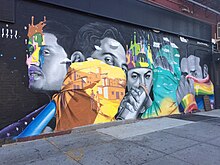Public acceptance

Although street art may be ubiquitous around the world, the popularity of its artistic expression is relatively recent. Street art has undergone a major transformation in public opinion to become socially accepted and respected in some public places. Even with this degree of acceptance, defacing private or public property with any and all message, whether it is considered art or not, is still widely illegal.
In the beginning, graffiti was the only form of street art that there was and it was widely considered to be a delinquent act of territorial marking and crude messaging. Initially, there were very clear divisions between the work of a street artist and the act of tagging a public or private property, but in recent years where the artists are treading the line between the two, this line has become increasingly blurred. Those who truly appreciate the work of famed street artists or street works of art are in acceptance of the fact that this art would not be the same without the medium being the street. The works are subject to whatever change or destruction may come because since they are created on public or private surfaces which are neither owned by the artist or permitted to be worked on by the property owners. This acceptance of the potential impermanence of the works of art and the public placement of the uncondoned works are what contribute to the meaning of the piece and therefore, what helps the growth of street art popularity.
Comments
Post a Comment